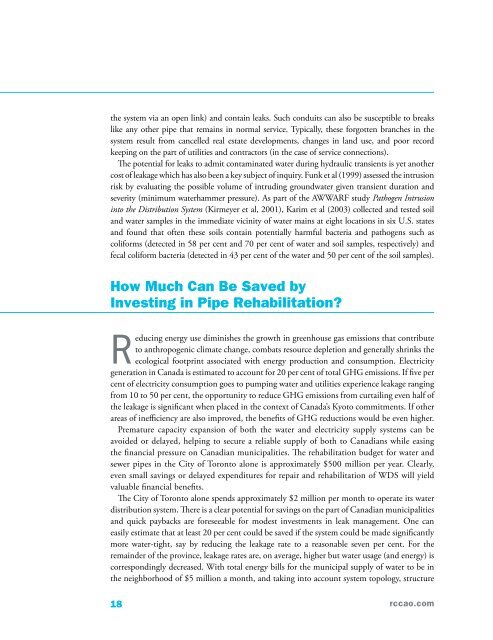Incorporating Sustainability in Infrastructure ROI: The energy ... - rccao
Incorporating Sustainability in Infrastructure ROI: The energy ... - rccao
Incorporating Sustainability in Infrastructure ROI: The energy ... - rccao
You also want an ePaper? Increase the reach of your titles
YUMPU automatically turns print PDFs into web optimized ePapers that Google loves.
the system via an open l<strong>in</strong>k) and conta<strong>in</strong> leaks. Such conduits can also be susceptible to breakslike any other pipe that rema<strong>in</strong>s <strong>in</strong> normal service. Typically, these forgotten branches <strong>in</strong> thesystem result from cancelled real estate developments, changes <strong>in</strong> land use, and poor recordkeep<strong>in</strong>g on the part of utilities and contractors (<strong>in</strong> the case of service connections).<strong>The</strong> potential for leaks to admit contam<strong>in</strong>ated water dur<strong>in</strong>g hydraulic transients is yet anothercost of leakage which has also been a key subject of <strong>in</strong>quiry. Funk et al (1999) assessed the <strong>in</strong>trusionrisk by evaluat<strong>in</strong>g the possible volume of <strong>in</strong>trud<strong>in</strong>g groundwater given transient duration andseverity (m<strong>in</strong>imum waterhammer pressure). As part of the AWWARF study Pathogen Intrusion<strong>in</strong>to the Distribution System (Kirmeyer et al, 2001), Karim et al (2003) collected and tested soiland water samples <strong>in</strong> the immediate vic<strong>in</strong>ity of water ma<strong>in</strong>s at eight locations <strong>in</strong> six U.S. statesand found that often these soils conta<strong>in</strong> potentially harmful bacteria and pathogens such ascoliforms (detected <strong>in</strong> 58 per cent and 70 per cent of water and soil samples, respectively) andfecal coliform bacteria (detected <strong>in</strong> 43 per cent of the water and 50 per cent of the soil samples).How Much Can Be Saved byInvest<strong>in</strong>g <strong>in</strong> Pipe Rehabilitation?Reduc<strong>in</strong>g <strong>energy</strong> use dim<strong>in</strong>ishes the growth <strong>in</strong> greenhouse gas emissions that contributeto anthropogenic climate change, combats resource depletion and generally shr<strong>in</strong>ks theecological footpr<strong>in</strong>t associated with <strong>energy</strong> production and consumption. Electricitygeneration <strong>in</strong> Canada is estimated to account for 20 per cent of total GHG emissions. If five percent of electricity consumption goes to pump<strong>in</strong>g water and utilities experience leakage rang<strong>in</strong>gfrom 10 to 50 per cent, the opportunity to reduce GHG emissions from curtail<strong>in</strong>g even half ofthe leakage is significant when placed <strong>in</strong> the context of Canada’s Kyoto commitments. If otherareas of <strong>in</strong>efficiency are also improved, the benefits of GHG reductions would be even higher.Premature capacity expansion of both the water and electricity supply systems can beavoided or delayed, help<strong>in</strong>g to secure a reliable supply of both to Canadians while eas<strong>in</strong>gthe f<strong>in</strong>ancial pressure on Canadian municipalities. <strong>The</strong> rehabilitation budget for water andsewer pipes <strong>in</strong> the City of Toronto alone is approximately $500 million per year. Clearly,even small sav<strong>in</strong>gs or delayed expenditures for repair and rehabilitation of WDS will yieldvaluable f<strong>in</strong>ancial benefits.<strong>The</strong> City of Toronto alone spends approximately $2 million per month to operate its waterdistribution system. <strong>The</strong>re is a clear potential for sav<strong>in</strong>gs on the part of Canadian municipalitiesand quick paybacks are foreseeable for modest <strong>in</strong>vestments <strong>in</strong> leak management. One caneasily estimate that at least 20 per cent could be saved if the system could be made significantlymore water-tight, say by reduc<strong>in</strong>g the leakage rate to a reasonable seven per cent. For therema<strong>in</strong>der of the prov<strong>in</strong>ce, leakage rates are, on average, higher but water usage (and <strong>energy</strong>) iscorrespond<strong>in</strong>gly decreased. With total <strong>energy</strong> bills for the municipal supply of water to be <strong>in</strong>the neighborhood of $5 million a month, and tak<strong>in</strong>g <strong>in</strong>to account system topology, structure18 <strong>rccao</strong>.com



